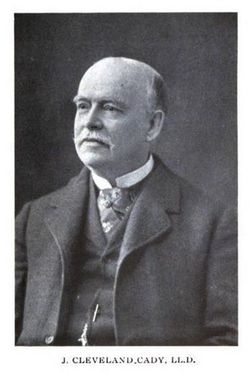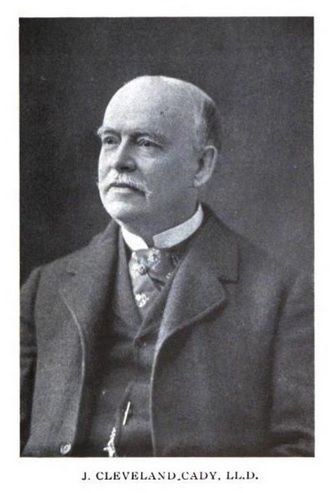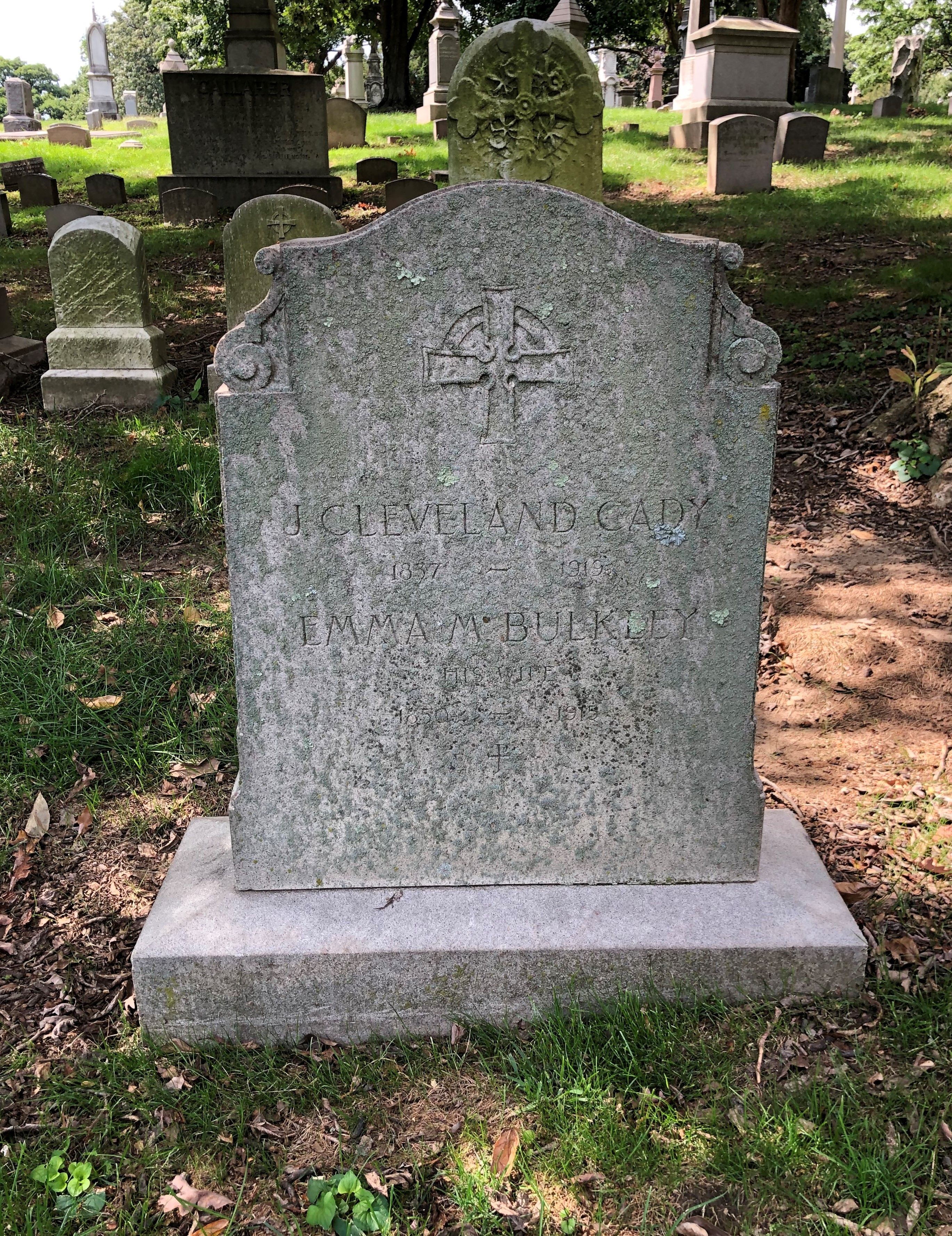Cady graduated from Trinity College, Hartford, Conn. in 1860; the following year he married Julia Bulkley of Orange, N.J.; they had one daughter.
A devoted Presbyterian, he served as head of the Sunday school at the Presbyterian Church of the Covenant, East 42nd St.; his first church commission was the First Presbyterian Church of Oyster Bay, N.Y.
Following the death of his first wife, he married her younger sister, Emma, by whom he had four more children.
Cady was the architect of the original Metropolitan Opera House, opened Oct 1883 (demolished in 1967). The original auditorium was gutted by fire Aug 27, 1892.
The American Museum of Natural History has a magnificently rusticated Richardsonian Romanesque entrance range by Cady and See, stretching 707 feet along its 77th St. frontage. The Museum also preserves its Cady auditorium, restored in 2002 as the Samuel J. and Ethel LeFrak Theater.
Cady and See designed the New York-Presbyterian Hospital, the Skin and Cancer Hospital, Bellevue Medical School, and the Hudson Street Hospital, and also many churches. They designed many college buildings, fifteen buildings for Yale University and buildings for Williams College, Trinity College in Hartford, Conn. and for Wesleyan University. Cady served as a trustee for Berea College in Berea, Ky, during the tenure of President William Goodell Frost, Cady's nephew. He designed many of the buildings on the Berea College Campus.
At Trinity College, Cady's 1878 St. Anthony Hall (Delta Psi)[6] is massively rusticated Richardsonian Romanesque in style, with narrow "arrow-slit" windows and even a tall cylindrical tower with a steep conical roof. The tower is half-embedded within the densely massed picturesque structure.
In 1880, Cady and See were hired by William West Durant to design a summer chapel on an island in Raquette Lake, N.Y., to entice his wealthy acquaintances to build their summer homes in the area. The chapel was constructed in the Stick Style. The plans were used in 1881, modified by Durant at the request of Harriet Beecher Stowe, for the Church of Our Saviour in Mandarin, Florida, and again in 1883 for the Church of the Good Shepherd in Beattystown, N.J.
Ten years later Cady again built a chapel on Raquette Lake, St. William's Roman Catholic Church on Long Point, again in Shingle Style, for Durant's employees and local residents. Both churches, only accessible by water, preserve and reflect the Adirondack heritage.
Among the firm's New York houses was the Isaac Stern House, 858 Fifth Avenue (demolished).
Cady was later in partnership with William S. Gregory, a long-term associate, as "Cady & Gregory", with offices at 40 West 32nd St., N.Y.
Buildings designed by Cady which survive and are listed on the U.S. National Register of Historic Places include:
American Museum of Natural History, Central Park West and 77th St., N.Y.(Cady, Berg & See)
Barron Library, 582 Rahway Ave., Woodbridge, N.J. (J. Cleveland Cady)
Boone Tavern Hotel, 100 Main St., Berea, Ky. (Cady and See)
Church of the Holy Communion, Summit Ave., Norwood, N.J. (J. Cleveland Cady)
Cliffside, Lawrence Ln. S of River Rd., Palisades, N.Y.(J. Cleveland Cady)
Demarest Railroad Depot, 38 Park St., Demarest Borough, N.J. (J. Cleveland Cady)
First Presbyterian Church of Albany, Albany, N.Y.(J. Cleveland Cady)
First Presbyterian Church of Oyster Bay, E. Main St., Oyster Bay, N.Y.(J. Cleveland Cady)
First Romanian-American Congregation Synagogue, 89-93 Rivington St., New York, City (J.C. Cady & Co.)
Grace Episcopal Church Complex, 15515 Jamaica Ave., Queens, N.Y.(Cady, Berg & See)
Othniel C. Marsh House, 360 Prospect St., New Haven, Conn. (J. Cleveland Cady), a U.S. National Historic Landmark
One or more properties in Plantsville Historic District, Roughly bounded by Prospect St., Summer St., Quinnipiac River, Grove St., S. Main St., W. Main St., and West St., Southington, Conn. (J. Cleveland Cady)
Saint Anthony Hall, 340 Summit St., Hartford, Conn. (J. Cleveland Cady)
St. William's Catholic Church, Long Point on Raquette Lake, Long Lake, N.Y. J.C. Cady & Co.)
One or more properties in Upper Closter-Alpine Historic District, Roughly bounded by Forest St., Old Dock Rd., School House Ln., Church St. and Closter Dock Rd., Alpine, N.J. (J. Cleveland Cady)
Cady graduated from Trinity College, Hartford, Conn. in 1860; the following year he married Julia Bulkley of Orange, N.J.; they had one daughter.
A devoted Presbyterian, he served as head of the Sunday school at the Presbyterian Church of the Covenant, East 42nd St.; his first church commission was the First Presbyterian Church of Oyster Bay, N.Y.
Following the death of his first wife, he married her younger sister, Emma, by whom he had four more children.
Cady was the architect of the original Metropolitan Opera House, opened Oct 1883 (demolished in 1967). The original auditorium was gutted by fire Aug 27, 1892.
The American Museum of Natural History has a magnificently rusticated Richardsonian Romanesque entrance range by Cady and See, stretching 707 feet along its 77th St. frontage. The Museum also preserves its Cady auditorium, restored in 2002 as the Samuel J. and Ethel LeFrak Theater.
Cady and See designed the New York-Presbyterian Hospital, the Skin and Cancer Hospital, Bellevue Medical School, and the Hudson Street Hospital, and also many churches. They designed many college buildings, fifteen buildings for Yale University and buildings for Williams College, Trinity College in Hartford, Conn. and for Wesleyan University. Cady served as a trustee for Berea College in Berea, Ky, during the tenure of President William Goodell Frost, Cady's nephew. He designed many of the buildings on the Berea College Campus.
At Trinity College, Cady's 1878 St. Anthony Hall (Delta Psi)[6] is massively rusticated Richardsonian Romanesque in style, with narrow "arrow-slit" windows and even a tall cylindrical tower with a steep conical roof. The tower is half-embedded within the densely massed picturesque structure.
In 1880, Cady and See were hired by William West Durant to design a summer chapel on an island in Raquette Lake, N.Y., to entice his wealthy acquaintances to build their summer homes in the area. The chapel was constructed in the Stick Style. The plans were used in 1881, modified by Durant at the request of Harriet Beecher Stowe, for the Church of Our Saviour in Mandarin, Florida, and again in 1883 for the Church of the Good Shepherd in Beattystown, N.J.
Ten years later Cady again built a chapel on Raquette Lake, St. William's Roman Catholic Church on Long Point, again in Shingle Style, for Durant's employees and local residents. Both churches, only accessible by water, preserve and reflect the Adirondack heritage.
Among the firm's New York houses was the Isaac Stern House, 858 Fifth Avenue (demolished).
Cady was later in partnership with William S. Gregory, a long-term associate, as "Cady & Gregory", with offices at 40 West 32nd St., N.Y.
Buildings designed by Cady which survive and are listed on the U.S. National Register of Historic Places include:
American Museum of Natural History, Central Park West and 77th St., N.Y.(Cady, Berg & See)
Barron Library, 582 Rahway Ave., Woodbridge, N.J. (J. Cleveland Cady)
Boone Tavern Hotel, 100 Main St., Berea, Ky. (Cady and See)
Church of the Holy Communion, Summit Ave., Norwood, N.J. (J. Cleveland Cady)
Cliffside, Lawrence Ln. S of River Rd., Palisades, N.Y.(J. Cleveland Cady)
Demarest Railroad Depot, 38 Park St., Demarest Borough, N.J. (J. Cleveland Cady)
First Presbyterian Church of Albany, Albany, N.Y.(J. Cleveland Cady)
First Presbyterian Church of Oyster Bay, E. Main St., Oyster Bay, N.Y.(J. Cleveland Cady)
First Romanian-American Congregation Synagogue, 89-93 Rivington St., New York, City (J.C. Cady & Co.)
Grace Episcopal Church Complex, 15515 Jamaica Ave., Queens, N.Y.(Cady, Berg & See)
Othniel C. Marsh House, 360 Prospect St., New Haven, Conn. (J. Cleveland Cady), a U.S. National Historic Landmark
One or more properties in Plantsville Historic District, Roughly bounded by Prospect St., Summer St., Quinnipiac River, Grove St., S. Main St., W. Main St., and West St., Southington, Conn. (J. Cleveland Cady)
Saint Anthony Hall, 340 Summit St., Hartford, Conn. (J. Cleveland Cady)
St. William's Catholic Church, Long Point on Raquette Lake, Long Lake, N.Y. J.C. Cady & Co.)
One or more properties in Upper Closter-Alpine Historic District, Roughly bounded by Forest St., Old Dock Rd., School House Ln., Church St. and Closter Dock Rd., Alpine, N.J. (J. Cleveland Cady)
Family Members
Sponsored by Ancestry
Advertisement
Advertisement




















